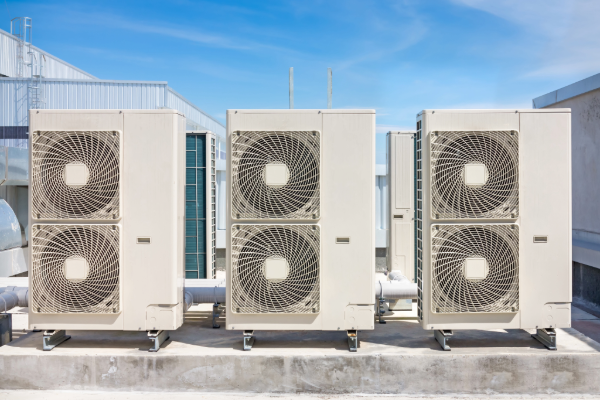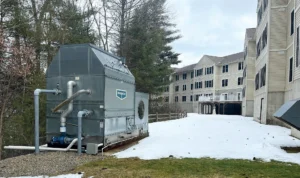At LC Anderson, we understand the ever-growing need for commercial facilities to prioritize energy efficiency. Lighting retrofits, smart building controls – these are all important strategies. But what about the heart of your building’s comfort – the HVAC system? Enter Variable Refrigerant Flow (VRF) systems, a technology rapidly gaining traction for its efficiency prowess.
VRF Systems vs. Traditional HVAC: A Tale of Two Approaches
Traditional HVAC systems, like constant air volume (CAV) or chilled water loops, often rely on a one-size-fits-all approach. A central unit blasts conditioned air throughout the building, regardless of individual zone requirements. This can lead to wasted energy in underused spaces or uneven comfort levels.
VRF systems, on the other hand, offer a more nuanced solution. They utilize a single outdoor condensing unit connected to multiple indoor fan coil units strategically placed throughout the building. The key lies in the “variable” aspect:
- Precision Cooling and Heating: VRF systems use inverter-driven compressors that adjust refrigerant flow based on real-time needs. This eliminates the inefficient on/off cycling common in traditional systems, leading to smoother and more efficient operation.
- Zonal Comfort: Individual indoor units can be controlled independently, creating customized temperature settings for different areas. This is perfect for buildings with varying occupancy patterns or specific comfort needs in certain zones, like server rooms or conference areas.
Beyond Efficiency: Additional Benefits of VRF Systems
The energy savings potential of VRF systems is significant. Studies suggest a 20-40% improvement over conventional systems. But the benefits extend beyond just the bottom line:
- Reduced Ductwork: VRF systems utilize refrigerant piping instead of bulky air ducts. This translates to lower installation costs, increased usable space, and potentially faster installation times.
- Flexibility: VRF systems are modular and scalable, allowing for future expansion or adjustments to building layout. This is particularly valuable for dynamic businesses.
- Quiet Operation: VRF systems are known for their quieter operation compared to traditional systems, contributing to a more comfortable work environment.
Unlocking VRF’s Efficiency: The Importance of Precision
While VRF systems boast impressive efficiency advantages, it’s important to remember they are precision instruments. Unlike traditional, one-size-fits-all HVAC systems, VRF relies on a network of precisely sized and calibrated components. These include:
- Variable-speed compressors: These adjust cooling or heating output based on real-time needs, minimizing energy waste.
- Electronic refrigerant control: VRF systems meticulously manage refrigerant flow to individual indoor units, ensuring optimal comfort and efficiency.
- Precise refrigerant charge: The amount of refrigerant in the system is crucial for peak performance. An overcharged or undercharged system can significantly impact efficiency and even lead to component failure.
Why Installation and Maintenance Matter
Given the intricate nature of VRF systems, the efficiency gains touted with VRF systems are contingent upon a well-designed, meticulously installed, and properly maintained system.
Here’s why:
- Proper System Design and Installation: A qualified team of engineers and technicians will ensure the VRF system is correctly sized for your building’s specific needs and meticulously installed to minimize leaks and maximize efficiency. Improper installation can lead to refrigerant charge imbalances, hindering performance and increasing energy consumption.
- Skilled Service and Maintenance: Regular maintenance by certified technicians helps maintain optimal performance. This includes tasks like leak detection, refrigerant level checks, and cleaning of coils and filters. Neglecting maintenance can lead to inefficiencies, reduced lifespan of components, and even potential system failure.
By prioritizing these aspects, you can unlock the full potential of VRF technology and experience significant energy savings alongside exceptional comfort control.
Partnering for Peak Performance: Selecting the Right Contractor
At LC Anderson, we understand the importance of maximizing VRF system efficiency. Our team has a proven track record of successful VRF installations and a deep understanding of the technology’s nuances.
We offer a comprehensive approach to VRF systems, including:
- Expert Engineering: Our engineers will design a VRF system tailored to your building’s specific needs, ensuring optimal efficiency and comfort zone control.
- Meticulous Installation: Our experienced technicians prioritize leak-free installation and precise refrigerant charge for peak performance from the start.
- Ongoing Maintenance: Our VRF-trained technicians will provide ongoing maintenance to keep your system operating efficiently for years to come.
By choosing LC Anderson, you can be confident that your system is designed, installed, and maintained to deliver the efficiency, comfort, and cost savings you expect.
Is VRF Right for Your Facility?
While VRF offers compelling advantages, it’s not a one-size-fits-all solution. Here are some factors to consider:
- Building Size and Layout: VRF systems excel in mid-sized to large buildings with diverse comfort needs across zones.
- Initial Investment: VRF systems typically have a higher upfront cost compared to traditional systems. However, programs like Mass Save can provide significant financial incentives to bridge the gap. Additionally, energy savings and longer lifespan can offset this cost over time. By exploring rebate programs and replacing outdated systems, the initial cost of VRF can become much more manageable. To see this concept in action, read the Case Study: Brae Burn Country Club’s Transition to Eco-Friendly Heating and Cooling.
The Future is Looking VRF-y
As energy efficiency continues to climb the priority list for commercial facilities, VRF systems are poised to play a significant role. Their ability to deliver targeted comfort while minimizing energy consumption makes them a compelling choice. At LC Anderson, our team of HVAC experts can help you assess your facility’s needs and determine if VRF is the right fit for your path to a more sustainable future.
Let’s discuss how VRF technology can transform your building’s comfort and efficiency. Contact LC Anderson today!



